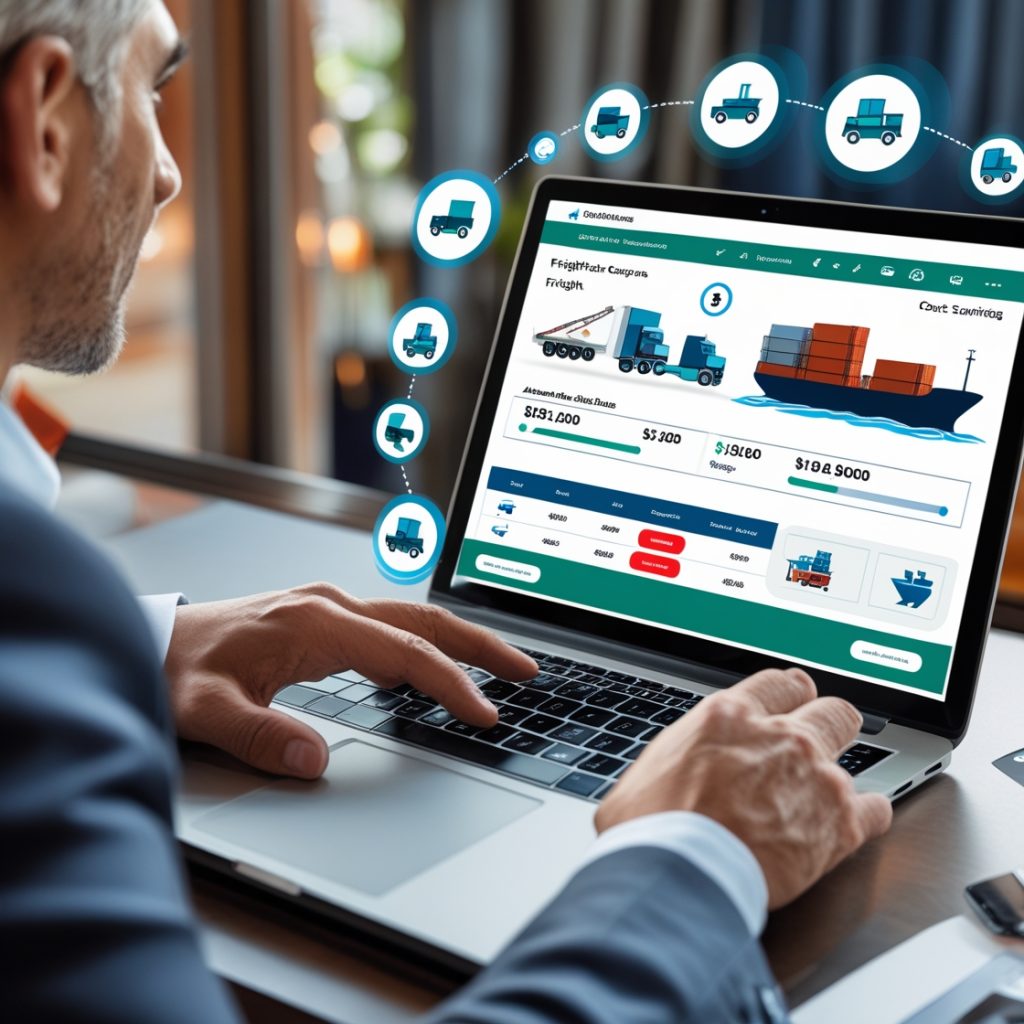Digitaaliset rahtitarjousympäristöt vauhdittavat kuljetusliikkeiden kuormien yhdistämistä
Nykypäivän nopeasti kehittyvässä logistiikkamaailmassa digitaaliset rahdinkilpailutusjärjestelmät mullistavat kuljettajien ja lähettäjien välisen dynamiikan. Nämä järjestelmät helpottavat rahdinkilpailutusta, parantavat kuljettajien kuormien yhdistämistä ja vauhdittavat kuorma-autorahtiautomaation maksimointia – mikä olennaisesti vähentää tehottomuutta, kuten tyhjänä ajettuja kilometrejä ja rahtikuljetusten optimoinnin maksimointia.
Tässä artikkelissa selitetään digitaalisten rahtitarjousympäristöjen suurimmat edut ja ominaisuudet ja tuodaan esiin, kuinka ne antavat kuljetusliikkeille mahdollisuuden maksimoida rahtikuljetusten yhdistämisen, parantaa kuljetusliikkeen rahtinäkyvyyttä ja hyödyntää kuljetusliikkeen rahtianalytiikkaa tietoisempien päätösten tekemiseksi.
Mitä ovat digitaaliset rahdinkilpailutusympäristöt?
Digitaaliset rahdinkilpailutusjärjestelmät ovat ohjelmistoja, jotka kilpailuttavat rahtisopimukset sähköisesti kuljetusliikkeiden ja lähettäjien välillä automaattisesti. Toisin kuin paperipohjaiset manuaaliset prosessit, joissa käytetään myös puhelinsoittoja, digitaaliset rahdinkilpailutusjärjestelmät automatisoivat kuljetusliikkeiden rahtisopimukset välittömästi reaaliaikaisen kuormauslistaintegraation ja -viestinnän avulla.
Nämä verkkosivustot ovat a truckers freight marketplace, jossa liikenteenharjoittajat tekevät tarjouksia kuormista, neuvottelevat rahtihinnoista ja saavat sopimuksia, jotka parhaiten vastaavat heidän kuljetuskapasiteettiaan ja toiminnallisia tavoitteitaan.
Miksi kuorman ja kuljetuskaluston täsmäytys on tärkeää
Rahtikuorman täsmäytys määritellään prosessiksi, jossa yhdistetään olemassa olevat rahtikuormat oikeisiin kuljetusliikkeisiin pyrkien maksimoimaan käyttöaste ja estämään toiminnan tehottomuus. Oikea kuorman täsmäytys on tärkeää, koska:
- Se tuhoaa tyhjät kilometrit kuorma-autoilussa, mikä on tuhlaavaista ja ympäristölle haitallista.
- Se parantaa omaisuuden käyttöastetta optimoimalla rahdin sopivaan kuorma-auton kapasiteettiin.
- Se optimoi rahdinkuljettajien rahdin näkyvyyden, jotta rahdinkuljettajat ja lähettäjät voivat seurata kuorman tilaa reaaliajassa.
- Se optimoi rahtikuljetusten täsmäytyksen oikea-aikaisten toimitusten ja kustannussäästöjen saavuttamiseksi.
Hyödyntämällä digitaalisia alustoja operaattorit voivat automatisoida täsmäytyksen ja nopeuttaa sitä, tehdä siitä tarkempaa ja kannattavampaa.
Digitaalisten rahtikilpailutusplattfomien pääominaisuudet
1. Automatisoitu rahdin kilpailutus kuljetusliikkeille
Nämä järjestelmät tarjoavat kuorma-autojen rahtitarjouskilpailu automaatio, jossa rahdinkuljettajat vastaanottavat ja vastaavat rahtitarjouksiin sähköisesti. Tämä vähentää inhimillisiä virheitä, nopeuttaa sopimusten hyväksymistä ja antaa rahdinkuljettajille mahdollisuuden seulomaan useita kuormia perustuen rekkakuski rahtimaksut ja saatavuutta.
2. Reaaliaikainen kuormatilaintegraatio
Useiden kuormatilalautojen integrointi, mukaan lukien paikalliset kuormatilalaudat, kuten load board app Eurooppa, antaa rahdinkuljettajille runsaasti rahtimahdollisuuksia, joista valita. Rahtivalintojen yhdistäminen useiden rahtipörssien integroinnin avulla helpottaa tarjousten tekemistä ja tarjouskilpailuja.
3. Rahtiliikenteen edistynyt analytiikka
Sovelluksen myötä carrier freight analytics, liikenteenharjoittaja voi tarkastella hintakehitystä, kuorman hyväksyntätasoja ja kapasiteetin käyttöä. Kaikki on dataohjattua, ja sillä on tukeva rooli strategisissa päätöksissä ja parannetussa kuorma-autorahtisopimus neuvottelu.
4. Parannettu kuljetusrahtien näkyvyys
Verkkoalustat tarjoavat kokonaisvaltaisen näkyvyyden rahdin liikkeisiin. Tämä rahdinkuljettajan rahdin näkyvyys edistää avoimuutta ja parantaa kommunikaatiota lähettäjien ja kuljettajien välillä, mikä ehkäisee viivästyksiä ja kiistoja.
5. Rahtikuljetusten optimointityökalut
Rahtikuljetusten optimointityökalut analysoivat reittiä, kuorman tilavuutta ja ajoitusta minimoidakseen tyhjät kilometrit ja maksimoidakseen kuormatehokkuuden. Tämä merkitsee kustannussäästöjä ja kestävää toimintaa.
Digitaalisten rahtikilpailutuspalveluiden käytön edut
- Lisääntynyt tehokkuus: Rahtitarjousten ja kuormien täsmäytyksen automatisointi vähentää ajanhukkaa ja hallinnollista taakkaa.
- Parempi kuorman sovitus: Älykkäät algoritmit yhdistävät rahdin kuljetusliikkeisiin kapasiteetin, sijainnin ja hinta-asetusten perusteella.
- Kustannussäästöt: Paremmat reitit ja vähemmän tyhjiä kilometrejä tarkoittavat pienempiä toimintakustannuksia.
- Pääsy markkinoille: Kuljetusliikkeet pääsevät laajempaan lähettäjäverkostoon kuormataulujen ja alustaan sisällytettyjen markkinapaikkojen kautta.
- Tietoon perustuvat päätökset: Analytiikan käyttö parantaa ennustamista ja kuorman hyväksymisprosesseja.
- Skaalautuvuus: Alustat pystyvät mukautumaan saumattomasti muutoksiin rahtimäärissä ja kuljetuskapasiteetissa.
Kuinka GetTransport mahdollistaa kuljetusliikenteen kuormien täsmäytyksen
GetTransport on rahdinkuljetusalusta, joka yhdistää monia näistä ominaisuuksista tukeakseen kuorma-autoalaa. Vaikka kyseessä ei olekaan aggressiivinen myynti, on kuitenkin mielenkiintoista, että GetTransport ja vastaavat alustat tarjoavat:
- Saumaton kuorma-autojen rahtiautomaatio tarjouskilpailuja ja sopimuksia varten.
- Vankka carrier freight analytics hallintapaneelit.
- Reaaliaikainen rahdinkuljettajan rahdin näkyvyys GPS-paikannuksen avulla.
- Useita kuormatilaintegraatioita tukemaan rahdin kuljetusmahdollisuuksien yhdistämistä.
Tällaiset alustat mahdollistavat liikennöitsijöiden toiminnan tuottavuuden ja kannattavuuden lisäämisen ilman manuaalisen rahdin tarjouspyynnön aiheuttamaa päänsärkyä.
Käytännön ohjeita rahdinkuljettajille digitaalisten rahtitarjousjärjestelmien käyttöön
- Päivitä operaattoriprofiilit: Lisää tarkkaa tietoa rahtikapasiteetistasi voidaksesi houkutella vastaavia kuormia.
- Käytä Analyticsia: Käytä kuljetusliikenteen rahtianalytiikkaa kannattavien reittien ja optimaalisten rahtausmaksujen määrittämiseen.
- Integroi kuormataulut: Integroi nykyiset järjestelmäsi kuormatauluintegraatioiden avulla, jotta saat käyttöösi enemmän rahtia.
- Optimoi aikataulutus: Käytä rahtikuljetusten optimointityökaluja sellaisten reittien suunnitteluun, jotka vähentävät tyhjiä kilometrejä kuorma-autoliikenteessä.
- Pysy responsiivisena: Vastaa reaaliajassa rahtitarjouksiin lisätäksesi mahdollisuuksiasi voittaa sopimuksia.
Päätelmä
Digitaalinen tarjouskilpailu rahdista on muuttamassa kuorma-autoliikennettä virtaviivaistamalla rahdin tarjouskilpailuprosessia, maksimoimalla kuljetusliikkeiden kuormien täsmäytyksen ja mahdollistamalla älykkään rahtikuljetuksen optimoinnin. Automatisoidun kuorma-autojen rahdin tarjouskilpailun, kuljetusliikkeiden rahtianalytiikan ja näkyvyyden sekä kuormataulun integroinnin avulla alustat mahdollistavat kuljetusliikkeiden tyhjien kilometrien vähentämisen ja kannattavuuden lisäämisen.
Tällaisen teknologian sisällyttäminen ei ole enää valinnaista, vaan sitä edellyttävät operaattorit, jotka haluavat pysyä kilpailukykyisinä epävarmalla markkinalla. Esimerkiksi GetTransportin kaltaiset toiminnot havainnollistavat mekanismeja, joiden avulla digitaaliset alustat voivat auttaa operaattoreita maksimoimaan kapasiteetin, parantamaan kuormien täsmäyksen tarkkuutta ja maksimoimaan rahtikuljetusten tehokkuuden.
FAQ
Mitä on rahdinkuljettajan kuorman täsmäytys?
Rahtikuorman kohdistaminen on rahtikuormien yhteensovittamista kuljetusliikkeiden kanssa, joilla on vastaava kapasiteetti ja reitit, optimoiden näin käyttöasteen ja vähentäen samalla tyhjiä kilometrejä.
Miten digitaaliset rahtitarjousympäristöt optimoivat kuorma-autoliikennettä?
Ne voivat automatisoida tarjouskilpailuprosessin, tarjota reaaliaikaisen kuormataulun integroinnin ja tehdä reitti- ja kuormasovituspäätöksiä analytiikan avulla.
Onko digitaalisilla alustoilla potentiaalia minimoida kuorma-autojen tyhjänä ajoa?
Kyllä, optimoidun reittisuunnittelun ja kuorman kohdistuksen avulla digitaaliset alustat mahdollistavat kuljetusliikkeiden estää ajamasta kuorma-autoilla tyhjänä, mikä säästää rahaa ja vähentää päästöjä.
Mikä on kuljetusrahtinäkyvyyden tarkoitus?
Rahtiliikenteen näkyvyyden avulla lähettäjät ja kuljetusliikkeet voivat seurata lähetyksiä reaaliajassa, mikä parantaa viestintää ja vähentää viivästyksiä.
Ovatko nämä alustat sopivia Euroopassa sijaitseville operaattoreille?
Kyllä. Monilla näistä alustoista on ominaisuuksia, kuten kuormataulusovelluksen Eurooppa-integraatio, joka tukee Euroopan alueilla toimivia kuljetusliikkeitä.

 Digitaaliset rahtitarjousalustat edistävät rahdinkuljettajien kuorman sovittamista yhteen.">
Digitaaliset rahtitarjousalustat edistävät rahdinkuljettajien kuorman sovittamista yhteen.">